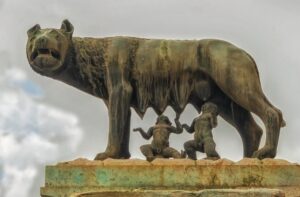
Myths about who St. Valentine was and what he did that began the Valentine’s Day tradition are numerous. Because of this, we must wonder if there was more than one, or if he existed at all. In one story he was jailed for marrying Christian couples. In another he was prosecuted for passing love letters from one prisoner to another. In one account he restored vision to a jailor’s blind daughter, and in another he cured an epileptic. There is consensus that he lived in the third century, was imprisoned because of his Christian convictions in the Roman Empire, and was martyred on February 14th for having encouraged acts of love.
 Whether or not St. Valentine lived and was martyred, St. Valentine’s Day was more than likely one of the seasonal celebrations adopted and revamped by the early Christian Church to allow their first converts to enjoy traditional holidays without having to stray from the faith. It was probably based upon the ancient Roman Festival of Lupercalia, celebrated every February 15. Its purpose was to ensure the fertility of the virgins who would soon bear Roman sons and to commemorate Lupa, the she-wolf who, according to legend, nursed Romulus and Remus.
Whether or not St. Valentine lived and was martyred, St. Valentine’s Day was more than likely one of the seasonal celebrations adopted and revamped by the early Christian Church to allow their first converts to enjoy traditional holidays without having to stray from the faith. It was probably based upon the ancient Roman Festival of Lupercalia, celebrated every February 15. Its purpose was to ensure the fertility of the virgins who would soon bear Roman sons and to commemorate Lupa, the she-wolf who, according to legend, nursed Romulus and Remus.
On this auspicious day, barely clad young Roman patrician males dressed as fawns. Two were carefully selected to represent Romulus and Remus. A female dog was chosen to represent the she-wolf. She was ritually sacrificed by slashing open her undersides and ripping out her womb. Her blood was doused onto strips of hide from a goat that had also been sacrificed. The strips were distributed to the young men. It was their job to dance through the assembly and anoint all virgins and pregnant women by striking them on the forehead with the bloody strips of animal hide.
Much could be said about the symbolic pattern of oppression and patriarchal violence toward in women as well as animals in this ritual celebration, but it is in this politically charged scene that we meet Cecilia of Rome in my new novel The Sculptor and the Saint. Here’s a sneak peek:
“Every year the families of the senatorial class gathered at Palatine Hill to observe the ritual slaughter of the she-wolf who suckled Romulus and Remus and to anoint the virgins whose chastity and subservience to their husbands ensured the integrity of the patriarchal bloodline.
suckled Romulus and Remus and to anoint the virgins whose chastity and subservience to their husbands ensured the integrity of the patriarchal bloodline.
“This was the day the girls of the empire who had passed their twelfth winter were consecrated to the Roman cause. This was the evening they were decreed future matrons of estates and bearers of sons who would rule the next generation. The dominance of the Roman Empire depended on this ritual celebration. Cecilia would be anointed— a fertile virgin, ripe for plucking by whatever member of the senatorial class her father found deserving of his assets—whether he was old or young, fat or lean, stern or gentle.”
And in true Valentine’s Day spirit, it is also within this macabre and sexually charged setting where my Cecilia meets Sebastian of Milan and falls instantly in love with him:
“Her body lost all sensation when she glanced up to see Sebastian executing his initial circles down the center of the aisle in which she stood. His was the face of a cherub who had grown into manhood. She forced herself to raise her gaze from his bare young male body to appreciate a wayward dark curl that graced his right temple, as the rest of his full head of hair tumbled toward his bare shoulders. His gaze, so sweet, so sincere. He would soon be looking into her eyes and confirming her fertility with the hide of the goat and the blood of the she-wolf’s womb. Her knees gave way as he neared. She stumbled backward.”
Valentine’s Day has a rich and twisted history of ritual love. For all its trials and tribulations, I hope you have a great one!







